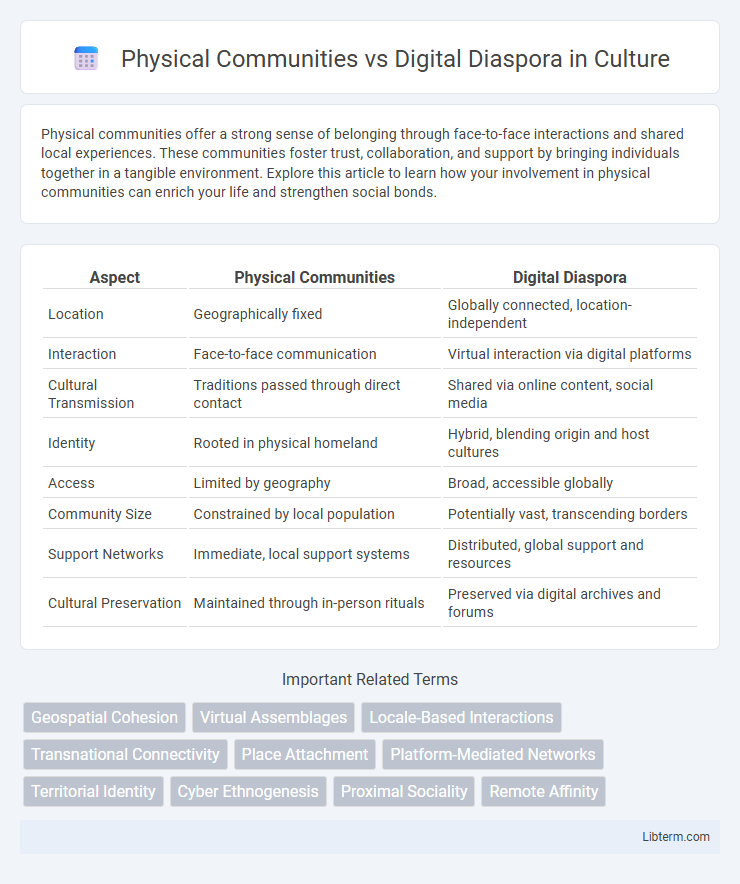Physical communities offer a strong sense of belonging through face-to-face interactions and shared local experiences. These communities foster trust, collaboration, and support by bringing individuals together in a tangible environment. Explore this article to learn how your involvement in physical communities can enrich your life and strengthen social bonds.
Table of Comparison
| Aspect | Physical Communities | Digital Diaspora |
|---|---|---|
| Location | Geographically fixed | Globally connected, location-independent |
| Interaction | Face-to-face communication | Virtual interaction via digital platforms |
| Cultural Transmission | Traditions passed through direct contact | Shared via online content, social media |
| Identity | Rooted in physical homeland | Hybrid, blending origin and host cultures |
| Access | Limited by geography | Broad, accessible globally |
| Community Size | Constrained by local population | Potentially vast, transcending borders |
| Support Networks | Immediate, local support systems | Distributed, global support and resources |
| Cultural Preservation | Maintained through in-person rituals | Preserved via digital archives and forums |
Understanding Physical Communities
Physical communities are groups of people connected by geographic proximity, shared spaces, and face-to-face interactions, fostering strong social bonds and collective identity. These communities rely on tangible environments where cultural practices, local customs, and social norms are maintained and transmitted through direct communication. Understanding physical communities involves recognizing the importance of spatial relationships and social networks that sustain cooperation, support systems, and a sense of belonging.
Defining Digital Diaspora
Digital diaspora refers to the dispersed communities of people who maintain cultural, social, and emotional connections through online platforms despite geographical separation. Unlike physical communities bound by location, digital diasporas leverage the internet to preserve identity, share knowledge, and mobilize resources across borders. Key aspects include virtual networks, transnational communication, and collective memory sustained through social media, forums, and digital archives.
Historical Evolution of Community Connections
Physical communities have historically been anchored in geographic proximity, fostering face-to-face interactions and shared cultural practices essential for social cohesion. Digital diaspora emerged with the rise of the internet, enabling dispersed populations to maintain cultural identity and communicate across global distances through virtual platforms. This evolution reflects a shift from tangible, localized bonds to dynamic, technology-mediated networks redefining the concept of community connectivity in the modern era.
Key Characteristics: Physical vs Digital
Physical communities are defined by geographic proximity, face-to-face interactions, and tangible social infrastructures that foster direct emotional and cultural connections. Digital diaspora communities transcend physical boundaries, utilizing online platforms, social media, and virtual networks to maintain identity, share information, and mobilize collective action across global locations. Key characteristics distinguishing physical communities include localized rituals and shared spaces, whereas digital diasporas emphasize cyberspace connectivity, instant communication, and decentralized organization.
Social Interaction and Human Relationships
Physical communities foster face-to-face social interactions, strengthening human relationships through non-verbal cues and shared experiences that enhance trust and emotional bonds. Digital diaspora relies on virtual platforms to maintain connections across geographical distances, enabling frequent communication but often lacking the depth of in-person engagement essential for deeper relational intimacy. Both forms of community influence social cohesion differently, with physical communities promoting embodied interactions and digital diasporas facilitating continuous yet sometimes superficial connectivity.
Cultural Preservation in Both Spaces
Physical communities anchor cultural preservation through shared rituals, language, and traditions passed down across generations in tangible environments. Digital diaspora leverages online platforms to sustain cultural identity by facilitating virtual gatherings, language learning apps, and digitized archives accessible worldwide. Both spaces play crucial roles in maintaining cultural heritage, enabling continuity amid geographic dispersal and globalization.
Impact of Technology on Community Dynamics
Technology revolutionizes community dynamics by enabling digital diaspora to maintain cultural ties despite geographical distances, significantly broadening social networks beyond physical communities. Virtual platforms facilitate instant communication, resource sharing, and collaborative identity formation, enhancing inclusivity and participation across global members. The shift also challenges traditional community structures, as technology fosters hybrid connections that blend local presence with worldwide interaction.
Challenges Faced by Physical Communities
Physical communities encounter challenges such as limited access to resources, social isolation in remote areas, and vulnerability to environmental changes that disrupt local infrastructure. Economic disparities often hinder community development and access to quality healthcare and education. These barriers contrast with digital diaspora groups that leverage technology for connectivity and resource sharing despite geographical dispersion.
Opportunities within Digital Diaspora
Digital diaspora offers unparalleled opportunities for global connectivity, allowing dispersed communities to maintain cultural ties through social media platforms and virtual events. These online networks facilitate knowledge exchange, collaborative projects, and economic ventures that transcend geographical limitations. Leveraging tools like blockchain and digital currencies further empowers digital diaspora members to support homeland development and foster transnational entrepreneurship.
The Future of Belonging: Hybrid Community Models
Hybrid community models blend physical communities with digital diaspora networks to redefine the future of belonging, offering enhanced connectivity and inclusivity beyond geographical limits. These models leverage digital platforms to maintain cultural identity and social ties while fostering localized interactions that strengthen communal support systems. By integrating in-person engagement with virtual spaces, hybrid communities address diverse needs, promoting resilience and adaptive social structures in an increasingly interconnected world.
Physical Communities Infographic

 libterm.com
libterm.com